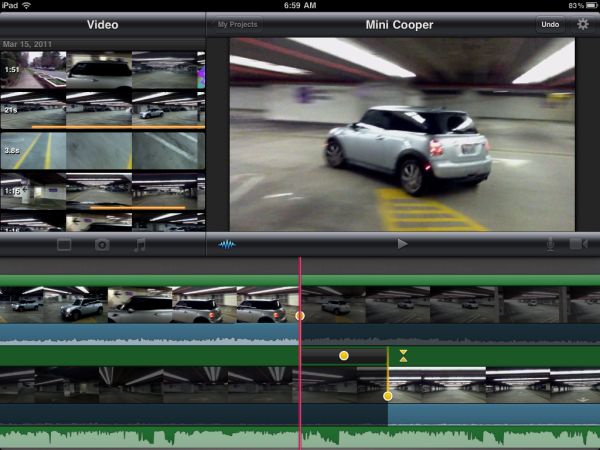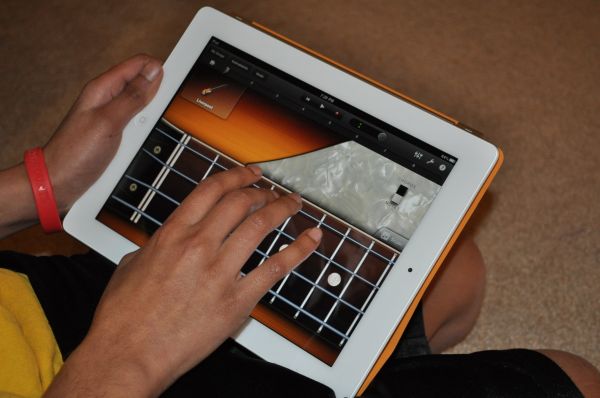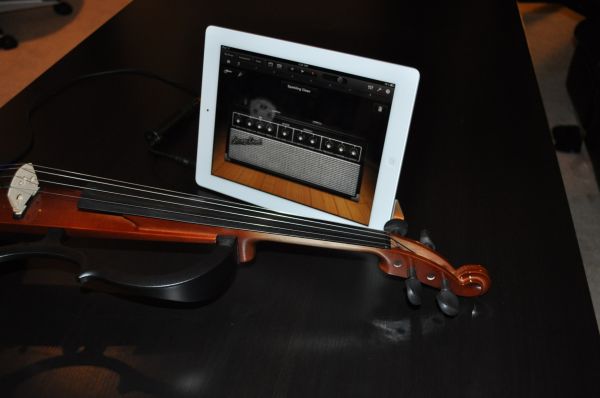The Apple iPad 2 Review
by Brian Klug, Anand Lal Shimpi & Vivek Gowri on March 19, 2011 8:01 PM ESTiMovie
by Vivek Gowri
Apple launched two new content-editing apps along with the iPad 2 - GarageBand and iMovie. iMovie is a $4.99 app available exclusively for iPad 2 (an updated iPhone 4/iPod touch 4 equivalent was launched simultaneously), so I'll start there.
iMovie basically lets you do a decent amount of video editing on the iPad itself. You can edit videos shot on the iPad, or video content imported from SD card using the camera connection kit. Unfortunately as we discovered in our testing, nearly all other sources of video aren't supported by iMovie. If you have grand visions of doing all of your video editing on the iPad 2 you'll want to hit the reset button on your expectations (or wait a few years until it's actually possible). Honestly, I can only see myself using it for video shot with the iPad, it makes the entire video editing process very streamlined on the device and makes video editing something you can do on the go. Just to test it out, I shot a series of videos of my car and stitched them together using iMovie, then added some titles and a soundtrack.
Being able to touch and swipe through the video clips and change the transitions and video cut points using a tactile input method actually makes it a lot easier to use than one would expect. Swipes and gestures rule the day, and it's a great way to edit various clips and put them together in a cohesive manner.
There's not a lot in the way of different options to deal with crossfades and transitions between clips, but the cross dissolve transition that is used as a default is pretty decent for amateur quality videos, especially since you can edit the length of the transition, and the various theme-specific transitions work too, if a little bit tacky.
But this is a video editing app for a 1.3lb tablet; considering that fact, you can get some pretty solid quality video out of it at the end. I'm pretty pleased with the video that I got out at the end, take a look for yourself.
You get a decent number of export options - Facebook, Youtube, Vimeo, CNN iReport (there's a CNN iMovie theme that can be added to videos as well), iTunes, and Camera Roll. From the camera roll, you can copy it to a computer and basically do whatever you want with it. iMovie isn't going to replace any serious video editing application, but I can see it being very useful during CES or another tradeshow - shooting video on the iPad, cutting it down, adding a few transitions, and uploading it in a matter of minutes, all from the same device.
Garage Band
by Vivek Gowri
GarageBand is a new app that Apple is releasing for both generations of iPad, for the same $4.99 price as iMovie, and beyond the basic premise of creating audio tracks from scratch, it's actually not that similar to the desktop app.
Apple has loaded a few instruments in GarageBand - a set of piano and keyboard options, a few drum kits, a vocal sampler/audio recorder from the mic, and even a virtual guitar amp, but the real story is the "Smart Instruments" that they have included.
Meet my brother, Gokul Gowri. He's 12, in 7th grade, and plays violin and piano at a relatively high level. I handed him my iPad 2 with GarageBand and asked him for his impressions.
After messing around with the included piano, he started experimenting with Smart Instruments. The first thing he said was that Smart Instruments could basically play the instrument for you, making good sounding audio clips and multilayered tracks easy to compose for even non-musically inclined people. There are four Smart Instruments - Piano, Bass, Guitar, and Drums. The Guitar is probably the most impressive one of the lot, with 6 strings and the ability to pick or strum at them. The cool part though, is that Smart Instruments will add the chords for you. They're preset chords and unfortunately, users can't define their own chords. That would let more advanced musicians really customise the guitar to their liking (my brother abandoned the smart chords really quickly after discovering he couldn't change them). The nice thing is that you can turn them off and pick your notes on the 6 strings individually. Smart Bass is exactly the same, except it's a four string bass instead of a guitar.
Smart Piano works similarly in that it takes away the actual keys and gives you a pad to press to get the note, with an option to sustain the notes. Smart Drums is another interesting one - you're provided with a grid dependant on volume and pattern complexity that you drag the various drum elements onto to generate a full rhythm.
And then of course, there's autoplay. Press the note, it'll play an entire clip for you, with the complexity of the clip depending on the level of autoplay selected. It's pretty cool if you're not a music person, but if you are, you can actually produce an interesting rhythm with the different options in Smart Instruments. There's a maximum of 8 tracks allowed, and you can duplicate and loop them to create a full song.
My brother decided to hold an impromptu recording session and ended up with this:
It sounds pretty good, especially considering that it was produced by a 12 year old on an iPad in 30 minutes. What my brother ended up doing is layering all four smart instruments to start, then adding in some included loops of orchestra strings to generate the second half of the clip. Pretty simple stuff, which is the goal behind GarageBand - allowing users to create complex sounds using simple musical constructs.
I personally was more curious about the virtual guitar amp. I'm a violinist who's been using an electric for the last couple of years, and I was curious to see if I could actually make use of the amp. I thought Apple would be using some form of line-in 3.5mm connector, but unfortunately, you have to get an external device to connect the electric guitar/violin. Apple recommends Apogee's Jam, though the AmpliTube iRig also works. I picked up an iRig ($39) to test out, since it's significantly cheaper than the $99 Apogee Jam, but the Jam is a studio quality device, so it's probably worth the extra money if you're really serious about it.
Unfortunately, the amp itself isn't all that great, for an electric violin at least. As a violinist, I have a different set of priorities than a guitarist - a clean sound is kind of the ultimate goal, even if a metal or some other after effect is applied. Most of the amp options in the virtual guitar amp don't give you very clear sound, so the violin ends up sounding pretty terrible. After listening to me play through the amp, my best friend took to calling my iPad the GarbageBand guitar amp. I think it'd be better for electric guitar players, since there isn't as much emphasis on clear sound, but it isn't going to replace a real amp by any stretch of the imagination.

















189 Comments
View All Comments
Azethoth - Monday, March 21, 2011 - link
No! 22 seconds is not fast enough. That is 20 seconds wasted each time you do that in a day.benonemusic - Monday, March 21, 2011 - link
Excellent writing and content as usual. As a longtime reader (this is my first post) with an editorial eye, I had a suggestion for future articles such as this with multiple authors but in which the main review is written in the first person singular. It was slightly disorienting to see three authors (Brian, Anand, Vivek) but then much of the article written with "I" (presumably Anand), you might want to avoid listing all three authors as "ands" in that case. One idea would be make the first author the one who is speaking in the first person voice (presumably Anand in the case) and the other two to be listed as "with." If the review is written as "we" then having all three of the authors as "ands" makes sense. There are multiple solutions. You can simply keep the "ands" and then indicate who the "I" is in the first instance. You could obviously say "one of us" in the first instance and indicate "Anand" in parentheses. And so on. Sorry for going on this long, but I'm big on bylines. Keep up the great work with the articles!embeddedGPU - Monday, March 21, 2011 - link
Can you clarify the floating point precision for your GPU GFLOPS figures ? You mention 20-/32-bit for nVidia, but I think the SGX is only 16-bit precision. If so, it's not a totally fair comparison...wellortech - Monday, March 21, 2011 - link
"If you fell in love with the original iPad, the iPad 2 is a significant upgrade."Really? Since when is thinner and a crappy camera a significant upgrade?
mcnabney - Monday, March 21, 2011 - link
You guys missed noticing something when documenting the huge step forward with the iPad2 GPU power.We now have iOS fragmentation.
The entire iPad1 generation was obsoleted in the graphics department. Now developers have to choose between writing for the iPad1 or iPad2. There is far too large of a gulf between the two platforms. To benefit from the GPU advancement, the massive installed base of the iPad1 will have to be written-off.
kmmatney - Monday, March 21, 2011 - link
I don't think this is true. First, we are only talking about 2 models, and second, they can just enable more graphics features for iPad 2. I can see where some truly advanced games might only be written for the iPad 2 in the future, but there is really no way to avoid that.Azethoth - Monday, March 21, 2011 - link
There always was and always will be iOS fragmentation since the 2nd iDevice shipped.As for what it means in a practical sense: check out Infinity Blade on multiple devices (iPhone and iPad). See, not a big deal, content providers are used to scaling artwork and design.
Furthermore, iOS will suffer less from this than Android (fewer device specs). It is one of the aspects of the competition at this form factor that makes me think that Apple will do better than it does at the PC level. (Not that Apple PC profits are not insanely good for their industry: over 50% of entire industry by some accounting).
araczynski - Monday, March 21, 2011 - link
if you're after a notebook/pc replacement, you're kidding yourself with any tablet.if you're after a gaming device, you're golden :) especially if you think gaming on phone sized screens (this includes psp/ds/etc) is plain stupid.
mine is filled to the brim with games, no room for audio/video/etc, just pure games.
i love it, my daughter loves it, even my technophobe wife loves it.
its for entertainment, nothing more.
Azethoth - Monday, March 21, 2011 - link
It is for more than entertainment:You can amuse your cat with it as well!
coolio68 - Monday, March 21, 2011 - link
Great review Anand,regarding this comment though:'The real competition for the SGX 543MP2 will be NVIDIA's Kal-El. That part is expected to ship on time and will feature a boost in core count: from 8 to 12. The ratio of pixel to vertex shader cores is not known at this point but I'm guessing it won't be balanced anymore. NVIDIA is promising 3x the GPU performance out of Kal-El so I suspect that we'll see an increase in throughput per core.'
Worth bearing in mind a couple of things:
SGX 543MP can already incorporate 2 to 16 cores
The even higher performance SGX 554MP cores have also been announced in December
Power VR Series 6 (Rogue), the next-generation, can scale from 210 GFLOPS to 8 TFLOPS , and is already licensed by the usual suspects.
The A9600 chip announced by ST-E at MWC ,containing Rogue, is sampling in H2 2011.
Nvidia are gonna have their work cut out methinks, but the competition is great for the industry and consumers.